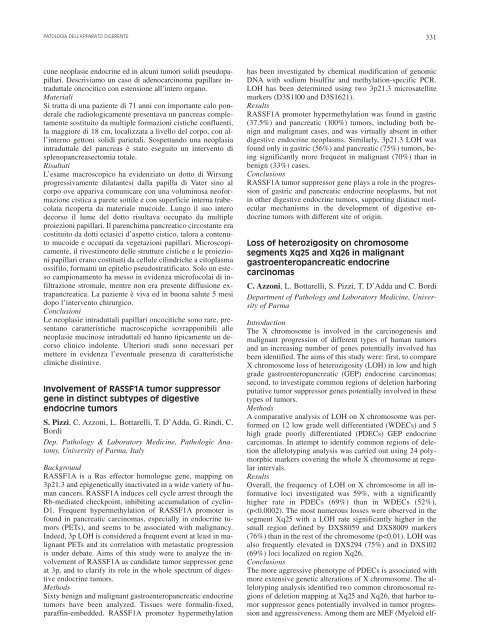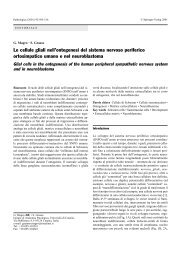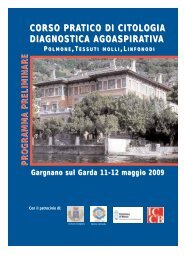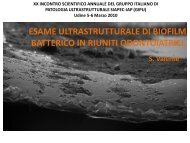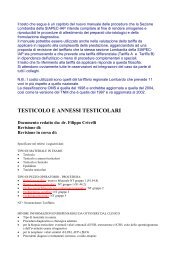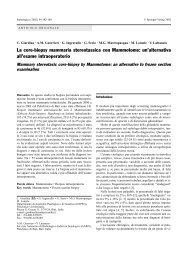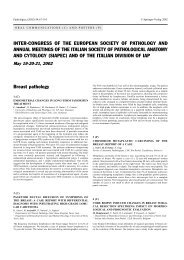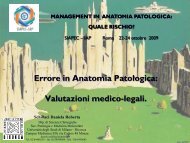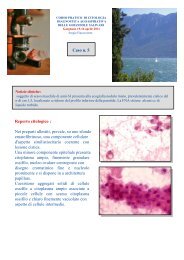330COMUNICAZIONI LIBEREStudio mutazionale dell’oncogene K-rasnel carcinoma duttale del pancreasN. Funel, I. Esposito, M. Menicagli, D. Campani, L.E.Pollina, N. Decarli, B. Chifenti, M. Morelli, G. Bertacca,C. Di Cristofano, A.O. Cavazzana, A. Santucci ** , M. DelChiaro * , U. Boggi * , F. Mosca * , G. BevilacquaDivisione di Anatomia Patologica e Diagnostica Molecolareed Ultrastrutturale; * Divisione di Chirurgia Generalee dei Trapianti, Dipartimento di Oncologia, dei Trapiantie delle Nuove Tecnologie in Medicina, Università diPisa, Pisa; ** Dipartimento Biologia Molecolare, Universitàdi SienaIntroduzioneMutazioni di K-ras sono frequenti nel carcinoma infiltrantedel pancreas e rappresentano un evento precoce nella cancerogenesiessendo presenti nelle lesioni preneoplastiche(PanIN). Le mutazioni riscontrate nel carcinoma del pancreasriguardano principalmente i codoni 12 e 13 per i qualisono state riportate frequenze comprese fra il 70% el’80%. Alterazioni del codone 61 sono state identificate inrari casi.Materiali e metodiDal dicembre 2001 al giugno 2004 sono pervenuti al nostrolaboratorio 89 casi di carcinoma duttale del pancreas. Sezionidi tessuto fresco di 52 carcinomi sono state sottoposte amicrodissezione laser (Leica ASLMD), dalle quali è statoestratto il DNA. Da 46 tumori sono state allestite colture cellulariprimarie, ottenendo 1 linea cellulare (PP78) e 4 coltureprimarie (PP109, PP117, PP147, PP161). L’analisi di K-rassui tumori primitivi e sulle relative colture cellulari nei codoni12, 13 (esone 1) e 61 (esone 2) è stata condotta con PCRe sequenziamento automatico.RisultatiL’analisi dei codoni 12 e 13 ha evidenziato mutazioni in43/52 neoplasie (82,7%). Le colture primarie presentavanotutte mutazioni sul codone 12 (PP109 GGT→GTT, PP117GGT→GAT, PP147 GGT→CGT, PP161 GGT→GAT). La lineaPP78 risultava normale nei codoni 12 e 13 e mutata nelcodone 61 (CAA→CAC). Tre dei 9 tumori primitivi risultatinormali nei codoni 12 e 13 presentavano una mutazione delcodone 61 (2 CAA→CAC e 1 CAA→CTA) e nessuno mostravadifferenze istologiche rispetto a quelli mutati nei codoni12 e 13. L’alterazione di K-ras nella nostra casistica risultava,complessivamente, pari all’88,5%. Il profilo mutazionaledelle colture cellulari era identico a quello riscontratonel tumore primitivo di origine. Indagini preliminari di post-genomica,elettroforesi bidimensionale delle proteine espettrometria di massa, condotte sulle colture primarie mutatenel codone 12 (PP117) e nel codone 61 (PP78) suggerisconol’attivazione di pathways metabolici diversi sostenutidalle diverse mutazioni.ConclusioniL’analisi del codone 61 ha determinato un incremento dellafrequenza delle mutazioni di K-ras nel cancro del pancreas rispettoall’analisi condotta a carico dei codoni 12 e 13(+5,7%). L’alterazione del codone 61 non è un evento frequentenel carcinoma del pancreas; per quanto riguarda le lineecellulari, è stata in precedenza documentata solo in un’altralinea cellulare (T3M4). Mutazioni differenti potrebberoattivare differenti vie metaboliche.Tumori solidi pseudopapillari del pancreas:revisione della casisticaA. Brighenti * , P. Capelli * , D. Reghellin * , I.Franceschetti * ,G. Martignoni ** , R. Salvia *** , G. Zamboni * , F. Menestrina **Anatomia Patologica, Università di Verona e ** Universitàdi Sassari; *** Endocrinochirurgia, Università di VeronaIntroduzioneLe neoplasie solido-pseudopapillari (SPT) del pancreas sonoestremamente rare, rappresentano infatti l’1-2% dei tumoridel pancreas esocrino. Vengono classificate dall’OrganizzazioneMondiale della Sanità (OMS) tra le neoplasie a comportamentobiologico incerto e tra i carcinomi. Questi ultimisono rari e segnalati in letteratura come casi isolati.MetodiLa nostra casistica comprende 36 casi, 25 dei quali provenientida un’unica Istituzione Chirurgica presso la quale il30% delle resezioni pancreatiche per neoplasia è stato effettuatoper neoplasie cistiche, di cui il 9% per neoplasie solidepseudopapillari. Di 30 casi disponiamo di dati anatomo-clinicicompleti con follow up medio di 5,5 anni.RisultatiDi 36 casi giunti alla nostra osservazione 33 pazienti eranofemmine e 3 maschi, con età media di 33 anni (intervallo: 7-69). Nei 30 casi con sede nota, era evidente una predilezionedi sede per il corpo-coda (corpo-coda: 21 casi, testa: 9 casi).L’aspetto macroscopico era quello di una neoformazione solidanel 42,5% dei casi, solido-cistica nel 42,5% e cisticanel15%; il diametro medio era di 5,5 cm (intervallo: 1,8-15cm). Uno dei 36 casi era maligno con la presenza di metastasiepatiche sincrone e trombosi della vena splenica, mentre in trecasi si sono riscontate caratteristiche “atipiche”, di incerto significato:due casi presentavano aggressività locale, uno confocale infiltrazione per continuità della capsula splenica e di unlinfonodo periviscerale e l’altro con invasione vascolare edaspetti suggestivi di trombosi vascolare. Il terzo caso presentavamarcate, seppur circoscritte, atipie citocariologiche. Questiultimi 3 pazienti sono vivi e liberi da malattia rispettivamentedopo 5 mesi, 15 mesi e 11 anni dall’intervento chirurgico.ConclusioniIl nostro studio dimostra che: 1) il SPT è una neoplasia rarae con una predilezione per i soggetti giovani e di sesso femminile;2) questo tumore insorge più frequentemente nel corpo-codapiuttosto che nella testa pancreatica; 3) gli aspetti“atipici” sono rari ed è necessario un lungo follow up perchiarirne il significato prognostico.Adenocarcinoma papillare intraduttaleossifilo del pancreasI. Franceschetti * , P. Capelli * , M. Gobbato * , C. Cannizzaro* , S. Pecori * , G. Martignoni ** , G. Zamboni * , F. Menestrina**Anatomia Patologica, Università di Verona e ** Universitàdi SassariIntroduzioneLe neoplasie cistiche rappresentano il 10% delle cisti pancreatichee l’1-3% dei carcinomi e la loro maggioranza è rappresentatada neoplasie cistiche mucinose e da cistoadenomi sierosi.I tumori pancreatici composti principalmente da celluleoncocitiche sono rari; aspetti ossifili si possono osservare in al-
PATOLOGIA DELL’APPARATO DIGERENTE331cune neoplasie endocrine ed in alcuni tumori solidi pseudopapillari.Descriviamo un caso di adenocarcinoma papillare intraduttaleoncocitico con estensione all’intero organo.MaterialiSi tratta di una paziente di 71 anni con importante calo ponderaleche radiologicamente presentava un pancreas completamentesostituito da multiple formazioni cistiche confluenti,la maggiore di 18 cm, localizzata a livello del corpo, con all’internogettoni solidi parietali. Sospettando una neoplasiaintraduttale del pancreas è stato eseguito un intervento displenopancreasectomia totale.RisultatiL’esame macroscopico ha evidenziato un dotto di Wirsungprogressivamente dilatantesi dalla papilla di Vater sino alcorpo ove appariva comunicare con una voluminosa neoformazionecistica a parete sottile e con superficie interna trabecolataricoperta da materiale mucoide. Lungo il suo interodecorso il lume del dotto risultava occupato da multipleproiezioni papillari. Il parenchima pancreatico circostante eracostituito da dotti ectasici d’aspetto cistico, talora a contenutomucoide e occupati da vegetazioni papillari. Microscopicamente,il rivestimento delle strutture cistiche e le proiezionipapillari erano costituiti da cellule cilindriche a citoplasmaossifilo, formanti un epitelio pseudostratificato. Solo un estesocampionamento ha messo in evidenza microfocolai di infiltrazionestromale, mentre non era presente diffusione extrapancreatica.La paziente è viva ed in buona salute 5 mesidopo l’intervento chirurgico.ConclusioniLe neoplasie intraduttali papillari oncocitiche sono rare, presentanocaratteristiche macroscopiche sovrapponibili alleneoplasie mucinose intraduttali ed hanno tipicamente un decorsoclinico indolente. Ulteriori studi sono necessari permettere in evidenza l’eventuale presenza di caratteristichecliniche distintive.Involvement of RASSF1A tumor suppressorgene in distinct subtypes of digestiveendocrine tumorsS. Pizzi, C. Azzoni, L. Bottarelli, T. D’Adda, G. Rindi, C.BordiDep. Pathology & Laboratory Medicine, Pathologic Anatomy,University of Parma, ItalyBackgroundRASSF1A is a Ras effector homologue gene, mapping on3p21.3 and epigenetically inactivated in a wide variety of humancancers. RASSF1A induces cell cycle arrest through theRb-mediated checkpoint, inhibiting accumulation of cyclin-D1. Frequent hypermethylation of RASSF1A promoter isfound in pancreatic carcinomas, especially in endocrine tumors(PETs), and seems to be associated with malignancy.Indeed, 3p LOH is considered a frequent event at least in malignantPETs and its correlation with metastatic progressionis under debate. Aims of this study were to analyze the involvementof RASSF1A as candidate tumor suppressor geneat 3p, and to clarify its role in the whole spectrum of digestiveendocrine tumors.MethodsSixty benign and malignant gastroenteropancreatic endocrinetumors have been analyzed. Tissues were formalin-fixed,paraffin-embedded. RASSF1A promoter hypermethylationhas been investigated by chemical modification of genomicDNA with sodium bisulfite and methylation-specific PCR.LOH has been determined using two 3p21.3 microsatellitemarkers (D3S1100 and D3S1621).ResultsRASSF1A promoter hypermethylation was found in gastric(37.5%) and pancreatic (100%) tumors, including both benignand malignant cases, and was virtually absent in otherdigestive endocrine neoplasms. Similarly, 3p21.3 LOH wasfound only in gastric (56%) and pancreatic (75%) tumors, beingsignificantly more frequent in malignant (70%) than inbenign (33%) cases.ConclusionsRASSF1A tumor suppressor gene plays a role in the progressionof gastric and pancreatic endocrine neoplasms, but notin other digestive endocrine tumors, supporting distinct molecularmechanisms in the development of digestive endocrinetumors with different site of origin.Loss of heterozigosity on chromosomesegments Xq25 and Xq26 in malignantgastroenteropancreatic endocrinecarcinomasC. Azzoni, L. Bottarelli, S. Pizzi, T. D’Adda and C. BordiDepartment of Pathology and Laboratory Medicine, Universityof ParmaIntroductionThe X chromosome is involved in the carcinogenesis andmalignant progression of different types of human tumorsand an increasing number of genes potentially involved hasbeen identified. The aims of this study were: first, to compareX chromosome loss of heterozigosity (LOH) in low and highgrade gastroenteropancreatic (GEP) endocrine carcinomas;second, to investigate common regions of deletion harboringputative tumor suppressor genes potentially involved in thesetypes of tumors.MethodsA comparative analysis of LOH on X chromosome was performedon 12 low grade well differentiated (WDECs) and 5high grade poorly differentiated (PDECs) GEP endocrinecarcinomas. In attempt to identify common regions of deletionthe allelotyping analysis was carried out using 24 polymorphicmarkers covering the whole X chromosome at regularintervals.ResultsOverall, the frequency of LOH on X chromosome in all informativeloci investigated was 59%, with a significantlyhigher rate in PDECs (69%) than in WDECs (52%),(p


